Hi-tech sprayers woo crowds at Cereals
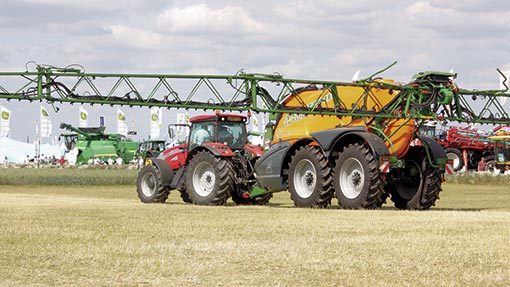
New spray tips and technologies for greater spraying control and flexibility were much in evidence in the Sprays & Sprayers section of the Cereals event.
Manufacturers said giving easier access to different spray characteristics by push button nozzle switching or droplet size manipulation should encourage operators to use the optimum spray quality for particular crops, changing conditions and maximum drift control.
TeeJet’s DynaJet Flex nozzle body is arguably the most high-tech approach. It has an electric actuator that pulses the spray output on and off 10 times every second.
Application rate is varied not by altering pressure, but by adjusting the duration of each “on” pulse.
“With an appropriate extended-range spray tip installed, the operator can easily change application rate without adjusting pressure, so the chosen spray quality is unaffected,” explains Martin Baxter of TeeJet Europe.
“For example, you could have a nozzle delivering 100 litres/ha and a coarse droplet at 1.4 bar pressure, and halve the application rate without changing either pressure or droplet size, so it clearly has potential for a precision-dosing approach to treatments.
“Equally, the operator could use the electronic control system to select a different spray quality – from medium to coarse for improved drift control, for example – without affecting the application rate or spray pattern.”
Although the DynaJet Flex body delivers spray liquid in a series of bursts rather than continuously, Mr Baxter insists no crop area is missed – partly because of the high pulse rate, but also because adjoining nozzles pulse on and off alternately.
The system does only work with non-air induction nozzles, which rely on the venturi effect to suck in air and mix it with the liquid to produce a coarser droplet spectrum – and it does not come cheap, he acknowledges.
“Fitting out a 24m boom will cost about £18,000 compared with £600-£700 for conventional air shut-off bodies,” he says. “Nonetheless, we’ve had growers expressing interest in the system and plan to have two or three sprayers operating in the UK for Beta testing.”
Giving easier access to the spray characteristics delivered by different nozzle designs is the approach taken by Pentair Hypro, with the Duo React body demonstrated at Cereals.
It has positions for two active spray tips – a single outlet and a four-way turret – controlled by individual air valves. Sprayers fitted with the system can be kitted out with two different types of nozzle or two nozzles of the same type but of different sizes and used either singly or at the same time.
“Our market research showed an appetite for an affordable means of switching so that operators can instantly switch from one type of nozzle to another,” says Roger James of Pentair Hypro.
“Farmers and operators said it would make them more likely to change nozzles in the field to improve precision and optimise treatments, as well as to control drift whenever necessary.”
A number of sprayer manufacturers – including Knight, Sands, Chafer and John Deere – have been quick to adopt the system as a more elegant alternative to twin spraylines or back-to-back nozzle installations.
“It simplifies our current approach of fitting two separate nozzle bodies every half metre, and it fits well into the space available on our booms,” says Brian Knight of Knight Farm Machinery.
“Our spray controller provides touch-screen switching between different nozzles and when using nozzles of the same type – for liquid fertiliser, for example – can automatically select outlet A or B, or A and B together to deliver the application rate required at any particular point in the field.”
Roger James says farmers are already suggesting quite radical possibilities for difficult to penetrate crop canopies, such as fitting inclined fine nozzles alternating forward and rearward paired with a coarser vertical spray that would entrain any very fine drift prone droplets into the crop while also providing another angle of attack into dense canopies.
Spray nozzle maker Lechler introduced a new range of air induction spray tips that are said to be stronger and easier to clean, as well as providing more consistent performance across all sizes.
“Our current air induction nozzle range is in two parts – ID and in smaller sizes IDK – with different operating pressure ranges,” says Andreas Bahnmüller of Lechler. “Now we have a range from 025 to 05 with the same 2-8 bar pressure range, with pressures from 4.5-5 bar providing the optimum performance.”
The new design is marginally shorter than the previous tip, but has more pronounced end structures protecting the outlet from debris and impact damage.
A plain inlet orifice makes it easier to wipe away dirt and chemical residues and the injector insert, which is sealed within the nozzle by an O-ring, can only be positioned in a way that lines up the air channels correctly.
“The long injector design of the Lecher ID3 air induction tips is responsible for high drift stability, with reduced fine droplet fraction at higher working pressures allowing fast working speeds,” says Mr Bahnmüller.
“From a practical point of view, the consistent operating pressure ratings across the range will make it easier for the operator to change between nozzles of different sizes.”
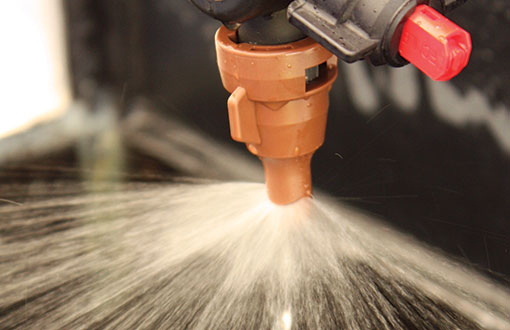
The Lechler Pre nozzle (pictured above) was developed from a liquid fertiliser design for Syngenta in Germany to provide improved drift control during pre-emergence oilseed rape herbicide treatments. Complaints of discolouration of plants in domestic gardens blamed on the herbicide resulted in a 100m buffer zone restriction being imposed. But thanks to the improved drift stability provided by the nozzle, that can be trimmed to 50m for treatments made close to buildings and other public areas. The 05-size nozzle produces a very coarse output at 2 bar pressure with less than 7% coefficient of variation in droplet size, says Lechler.
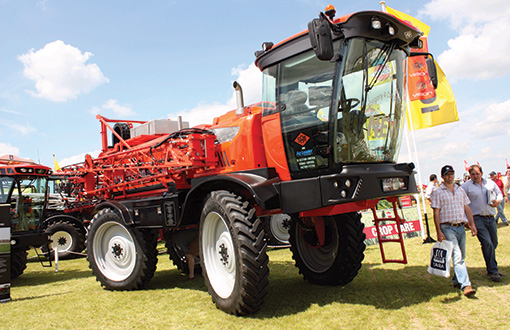
Although the chassis remains similar in concept, the Horizon self-propelled sprayer from Sands Agricultural Machinery (pictured above) has a more spacious cab with improved visibility that meets forthcoming stricter rules on pesticide exclusion. The in-house cabin design, with its single rear pillar providing clear rear three-quarters visibility to the booms, has generous leg room for tall operators and houses a new armrest control console with membrane switches, a multi-function joystick and electric spool valves. A Deutz six-cylinder engine to Euro 4/Tier 4 Final emissions rules brings added fuel economy and 212hp and 242hp respectively for the Horizon 4000 and 5000 sprayers.
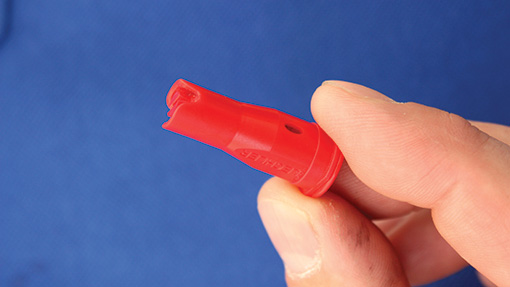
The ID3 range of air induction spray tips (pictured above) from Lechler is reckoned to be more robust (especially around the outlet) and easier to clean. There is also consistent operating pressure limits across the 025-5 size range to avoid potential confusion when switching between sizes.
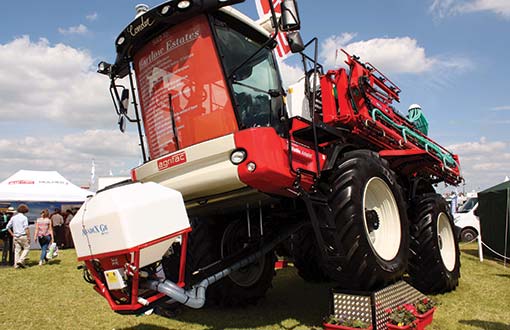
There were Avadex applicators for blackgrass control in all shapes and sizes at Cereals, with Agrifac showing this Techneat solution for a self-propelled sprayer (pictured above). The hopper, metering unit and fan are mounted on a frame slung beneath the chassis and lowered on hydraulic cylinders for refilling. Flexible pipes feed the distribution heads and deflector outlets positioned along the boom.

